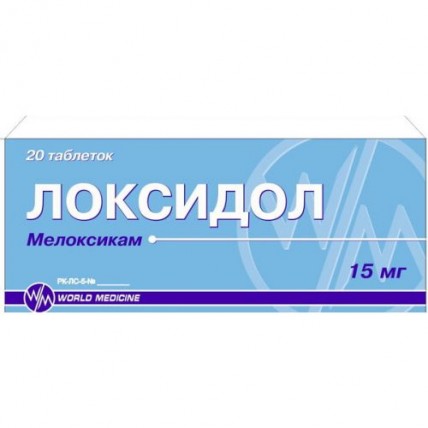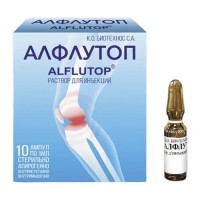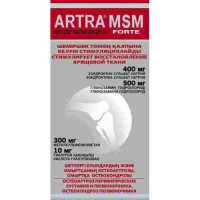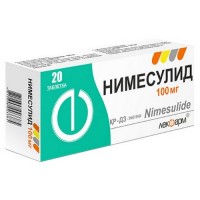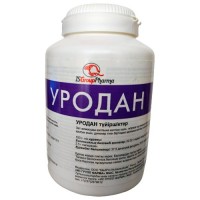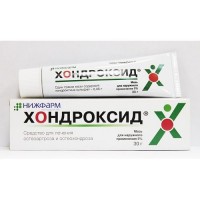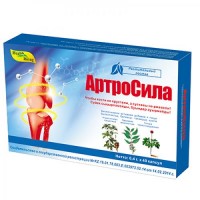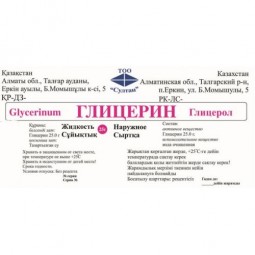Loxidol 15 mg (20 tablets)
- $26.30
The instruction for medical use
of LOKSIDOL medicine
the Trade name
Loksidol
Mezhdunarodnoye the unlicensed
name Meloksikam Lekarstvennaya a form
of the Tablet of 7.5 mg and 15 mg
Structure
One tablet contains
active agent - a meloksikam of 7.5 mg and 15 mg
excipients: cellulose microcrystalline (102), lactoses monohydrate, sodium citrate, krospovidon, K 30 povidone, silicon dioxide colloidal anhydrous, magnesium stearate
the Description
of the Tablet of round shape, with a flat surface, light yellow color (for a dosage of 7.5 mg),
Tablets of round shape, with a biconvex surface, light yellow color, with risky on one party (for a dosage of 15 mg)
Pharmacotherapeutic group
Anti-inflammatory and antirheumatic drugs. Non-steroidal anti-inflammatory drugs. Oksikama. Meloksikam.
The ATX M01AC06 code
the Pharmacological
Meloksikam Pharmacokinetics properties is well soaked up from digestive tract what the high absolute bioavailability of 89% testifies to.
At single dose of drug in the form of tablets the average maximum concentration in plasma is reached within 5-6 hours.
Meloksikam very well contacts proteins of plasma, especially albumine (99%). Gets into synovial fluid, concentration in synovial fluid makes about 50% of concentration in plasma. Distribution volume low, on average 11 liters.
Meloksikam is almost completely metabolized in a liver with formation
of the 4th pharmacological inactive metabolites. The main metabolite, 5 '-karboksimeloksikam (60% of dose size), is formed by oxidation of an intermediate metabolite, 5 '-hydroksimetilmeloksikama which is also excreted, but to a lesser extent (9% of dose size).
Elimination half-life of a meloksikam makes 15-20 hours. The plasma clearance averages 8 ml/min. It is removed equally with a stake and urine, mainly in the form of metabolites.
At elderly patients the plasma clearance is a little lower.
The pharmacodynamics
Meloksikam is derivative enoliyevy acid and belongs to group of non-steroidal anti-inflammatory drugs, has anti-inflammatory, analgetic and febrifugal effect. The mechanism of action is caused by ability to inhibit biosynthesis of prostaglandins — inflammation mediators at the expense of selection inhibition of TsOG-2, providing safer mechanism of action in connection with selection inhibition of TsOG-2 in comparison with TsOG-1. The therapeutic effect of NPVP is connected with inhibition of synthesis of TsOG-2 while the inhibition of TsOG-1 results in side effects from a stomach and kidneys. The selectivity of inhibition of TsOG-2 meloksikamy is confirmed to both in vitro, and in vivo. Meloksikam does not influence aggregation of thrombocytes and for a bleeding time at use in the recommended in vitro doses, unlike indometacin, diclofenac, an ibuprofen and Naproxenum which considerably inhibit aggregation of thrombocytes and increase a bleeding time.
Indications
- an osteoarthrosis (a pain syndrome in an osteoarthrosis)
- a pseudorheumatism
-
the Route of administration and doses ankylosing a spondylarthritis
the General day dose is accepted once, with water or other liquid during meal. Undesirable effects of use of the preprat can be reduced by use of low dosages of Loksidol.
Aggravations of an osteartroz: 7.5 mg of a meloksikam a day. If necessary the dose can be raised to 15 mg of a meloksikam a day.
Pseudorheumatism and ankylosing spondylarthritis: 15 mg of a meloksikam a day. Depending on therapeutic effect, the dose can be reduced to 7.5 mg/day.
At long treatment of patients of advanced age it is necessary to appoint a dose of 7.5 mg of a meloksikam a day.
Treatment of patients with the increased risk of emergence of side reactions it is necessary to begin with a dose 7.5 mg a day.
The daily dose of drug at dialysis patients with a renal failure should not exceed 7.5 mg of a meloksikam.
Duration of treatment and carrying out repeated courses depend on character and disease severity and is defined by the attending physician.
Side effects
not often ˃ 1%:
- a digestive disturbance, nausea, vomiting, an abdominal pain, dyspepsia, a meteorism, diarrhea
- anemia
- an itching, skin rash
- a headache
- hypostases
Seldom 0.1% - 1%:
- gastrointestinal bleeding
- temporary increase in transaminase or bilirubin
- a leukopenia, thrombocytopenia, an agranulocytosis, especially in case of simultaneous treatment by a methotrexate
- conjunctivitis, a disorder of vision, including illegibility of sight, emergence of a veil before eyes
- reaction a photosensitization, urticaria
- dizziness, a ring in ears, drowsiness,
- increase in the ABP, heartbeat, rushes of blood to the person
- change of indicators of function of kidneys (increase in level of creatinine and/or urea in blood)
is Very rare also lt, 0.1%:
- stomatitis, an esophagitis, gastritis, the digestive tract erosive cankers latent or obvious gastro intestinal bleedings
- perforation of a GIT, colitis, gastritis
- Stephens's syndrome - Johnson and a toxic epidermal necrolysis, a Quincke's disease, such vesical dermatitis, as a multiformny erythema
- anaphylactic/anaphylactoid reactions
- asthma attack, in particular at persons with an allergy to aspirin or other NPVP
- confusion of consciousness, feeling of intoxication, emotional lability
- interstitial nephrite, urination difficulty, including a sharp ischuria
- an acute renal failure
of the Contraindication
- hypersensitivity to a meloksikam or other component of drug
- a peptic ulcer of a stomach and duodenum in an aggravation phase
- a heavy renal failure (if the hemodialysis is not carried out)
- a heavy liver failure, a liver disease in the acute stage
- nonspecific ulcer colitis in an aggravation phase, Crohn's disease
- heavy heart failure
- gastrointestinal bleeding, recent cerebrovascular bleeding or other bleeding
- children's age up to 15 years
- pregnancy and the period of a lactation
- cross sensitivity to acetylsalicylic acid and other NPVP
- states after performing aortocoronary shunting
- an aspirinovy triad
- a hyperpotassemia
Medicinal interactions
Other NPVP, including salicylates (acetylsalicylic acid): simultaneous use more than one NPVP increases risk of formation of ulcers in a GIT and gastrointestinal bleedings owing to synergism of action. Combined use of a meloksikam and other NPVP is not recommended.
Anticoagulants, antiagregant, heparin for system use, thrombolytic means: increase risk of bleeding. In case of impossibility to avoid simultaneous use of these drugs, careful observation of effect of anticoagulants is necessary.
Lithium: NPVP increase concentration of lithium in plasma due to decrease in renal excretion of lithium. Combined use of lithium and NPVP is not recommended. In case of need such combination therapy should control concentration of lithium in plasma in an initiation of treatment, at selection of a dose and cancellation of a meloksikam.
Methotrexate: NPVP can reduce canalicular secretion of a methotrexate and thus increase concentration of a methotrexate in plasma. In need of combination therapy it is necessary to control a blood count and function of kidneys. It is necessary to be careful if NPVP and a methotrexate are applied at the same time within 3 days since concentration of a methotrexate in plasma can increase and, as a result, there can be toxic effects.
Cyclosporine: NPVP, having effect on renal prostaglandins, can increase nephrotoxicity of cyclosporine. In case of performing combination therapy it is necessary to control function of kidneys.
Intrauterine contraceptives: NPVP reduce efficiency of intrauterine contraceptives.
Diuretics: use of NPVP increases risk of developing an acute renal failure at patients with dehydration. The patients accepting at the same time to meloksika and diuretics have to receive enough liquid. Prior to treatment the research of function of kidneys is necessary.
Joint uses of NPVS with APF inhibitors are strengthened by effect of decrease in glomerular filtration. At patients with a renal failure it can lead ment of an acute renal failure.
NPVS can cause a delay of sodium, potassium, liquid and to weaken effect of saluretics. As a result, at predisposed patients the purpose of NPVS can lead to progressing of heart failure and hypertensia.
Antihypertensive drugs (for example, beta blockers, inhibitors of angiotensin-converting enzyme (APF), vazodilatator, diuretics): NPVP reduce effect of antihypertensive drugs, owing to inhibition of prostaglandins-vazodilatatorov. Holestiramin: increases removal of a meloksikam owing to binding it in a GIT.
The special
instructions Loksidol's Use, as well as other NPVP, demands strict observation of patients with gastrointestinal diseases in the anamnesis and also for patients, accepting anticoagulants.
NPVP inhibit synthesis of the renal prostaglandins necessary for maintenance of a renal blood-groove. With a reduced renal blood-groove the use of NPVP can cause the renal failure disappearing after drug withdrawal in patients. At patients with slightly or moderate renal failures the dose of drug can be not reduced, however careful control of function of kidneys is necessary.
In separate exceptional cases of NPVP can lead ment of interstitial nephrite, glomerulonephritis, renal medullary necrosis or development of a nephrotic syndrome. Patients with chronic kidney disease, after extensive surgeries (which caused a hypovolemia) and also patients with cirrhosis are inclined to such complications. Control of a diuresis and function of kidneys from the very beginning of therapy is in that case necessary.
NPVP at joint reception with diuretics can strengthen a delay of sodium, potassium and water in an organism and to affect natriuretic effect of diuretic drugs owing to what at predisposed patients the heart failure or arterial hypertension can arise or amplify.
With care appoint drug to the weakened patients, elderly people, patients with heart failure.
Meloksikam, as well as any other NPVP, can mask symptoms of the basic infectious disease.
As well as other medicines inhibiting synthesis of COG/prostaglandins, to meloksika can damage to fertilization process therefore it is not recommended to women who are going to become pregnant.
Intake of this drug is forbidden to patients, suffering from congenital intolerance or a syndrome glyukozo-galaktozny malabsorption.
Use in pediatrics
Drug is not used at children up to 15 years.
Use at pregnancy and the period of a lactation
it is necessary to Apply Loksidol in the first and second trimester only if the expected advantage exceeds potential risk. In the third trimester and in the period of a lactation the use of drug is contraindicated.
The feature of influence of medicine on ability to run motor transport and potentially dangerous mechanisms
From driving or mechanisms should abstain to patients with disorders of vision, to the patients noting drowsiness or other side effects from the central nervous system.
Overdose
Symptoms: dyspepsia, nausea, vomiting, abdominal pain.
Treatment: gastric lavage and symptomatic therapy. There is no specific antidote. The artificial diuresis and a hemodialysis are ineffective. Holesteramin accelerates removal of a meloksikam.
The form of release and packing
On 10 tablets place in blister strip packaging from a film of polyvinylchloride and aluminum foil.
On the 2nd planimetric packing together with the instruction for medical use in the state and Russian languages put in a box of cardboard.
To Store storage conditions at a temperature not over 25 s.
To store out of children's reach!
2 years
not to apply an expiration date after an expiration date.
Prescription status
According to the prescription
K.O Producer. MASTER К&К S.R. L.
, Boulevard Aurel Влайку № 82А, Constanta, Romania
(S.C. 'MAGISTRA С&С S.R.L.',
82A of Aurel Vlaicu Blvd., Constanta, Romania).
The owner of the registration certificate
of UORLD MEDITSIN Limited, Great Britain
the Owner of a trademark and the certificate of registration is the UORLD MEDITSIN Limited company, Great Britain
the Address of the organization accepting in the territory of the Republic of Kazakhstan claims from consumers on quality of products
of RK, Almaty, Turksibsky district, Suyunbaya Ave., 222
Ph. / fax: 8 (7272) 529090
of LOKSIDOL medicine
the Trade name
Loksidol
Mezhdunarodnoye the unlicensed
name Meloksikam Lekarstvennaya a form
of the Tablet of 7.5 mg and 15 mg
Structure
One tablet contains
active agent - a meloksikam of 7.5 mg and 15 mg
excipients: cellulose microcrystalline (102), lactoses monohydrate, sodium citrate, krospovidon, K 30 povidone, silicon dioxide colloidal anhydrous, magnesium stearate
the Description
of the Tablet of round shape, with a flat surface, light yellow color (for a dosage of 7.5 mg),
Tablets of round shape, with a biconvex surface, light yellow color, with risky on one party (for a dosage of 15 mg)
Pharmacotherapeutic group
Anti-inflammatory and antirheumatic drugs. Non-steroidal anti-inflammatory drugs. Oksikama. Meloksikam.
The ATX M01AC06 code
the Pharmacological
Meloksikam Pharmacokinetics properties is well soaked up from digestive tract what the high absolute bioavailability of 89% testifies to.
At single dose of drug in the form of tablets the average maximum concentration in plasma is reached within 5-6 hours.
Meloksikam very well contacts proteins of plasma, especially albumine (99%). Gets into synovial fluid, concentration in synovial fluid makes about 50% of concentration in plasma. Distribution volume low, on average 11 liters.
Meloksikam is almost completely metabolized in a liver with formation
of the 4th pharmacological inactive metabolites. The main metabolite, 5 '-karboksimeloksikam (60% of dose size), is formed by oxidation of an intermediate metabolite, 5 '-hydroksimetilmeloksikama which is also excreted, but to a lesser extent (9% of dose size).
Elimination half-life of a meloksikam makes 15-20 hours. The plasma clearance averages 8 ml/min. It is removed equally with a stake and urine, mainly in the form of metabolites.
At elderly patients the plasma clearance is a little lower.
The pharmacodynamics
Meloksikam is derivative enoliyevy acid and belongs to group of non-steroidal anti-inflammatory drugs, has anti-inflammatory, analgetic and febrifugal effect. The mechanism of action is caused by ability to inhibit biosynthesis of prostaglandins — inflammation mediators at the expense of selection inhibition of TsOG-2, providing safer mechanism of action in connection with selection inhibition of TsOG-2 in comparison with TsOG-1. The therapeutic effect of NPVP is connected with inhibition of synthesis of TsOG-2 while the inhibition of TsOG-1 results in side effects from a stomach and kidneys. The selectivity of inhibition of TsOG-2 meloksikamy is confirmed to both in vitro, and in vivo. Meloksikam does not influence aggregation of thrombocytes and for a bleeding time at use in the recommended in vitro doses, unlike indometacin, diclofenac, an ibuprofen and Naproxenum which considerably inhibit aggregation of thrombocytes and increase a bleeding time.
Indications
- an osteoarthrosis (a pain syndrome in an osteoarthrosis)
- a pseudorheumatism
-
the Route of administration and doses ankylosing a spondylarthritis
the General day dose is accepted once, with water or other liquid during meal. Undesirable effects of use of the preprat can be reduced by use of low dosages of Loksidol.
Aggravations of an osteartroz: 7.5 mg of a meloksikam a day. If necessary the dose can be raised to 15 mg of a meloksikam a day.
Pseudorheumatism and ankylosing spondylarthritis: 15 mg of a meloksikam a day. Depending on therapeutic effect, the dose can be reduced to 7.5 mg/day.
At long treatment of patients of advanced age it is necessary to appoint a dose of 7.5 mg of a meloksikam a day.
Treatment of patients with the increased risk of emergence of side reactions it is necessary to begin with a dose 7.5 mg a day.
The daily dose of drug at dialysis patients with a renal failure should not exceed 7.5 mg of a meloksikam.
Duration of treatment and carrying out repeated courses depend on character and disease severity and is defined by the attending physician.
Side effects
not often ˃ 1%:
- a digestive disturbance, nausea, vomiting, an abdominal pain, dyspepsia, a meteorism, diarrhea
- anemia
- an itching, skin rash
- a headache
- hypostases
Seldom 0.1% - 1%:
- gastrointestinal bleeding
- temporary increase in transaminase or bilirubin
- a leukopenia, thrombocytopenia, an agranulocytosis, especially in case of simultaneous treatment by a methotrexate
- conjunctivitis, a disorder of vision, including illegibility of sight, emergence of a veil before eyes
- reaction a photosensitization, urticaria
- dizziness, a ring in ears, drowsiness,
- increase in the ABP, heartbeat, rushes of blood to the person
- change of indicators of function of kidneys (increase in level of creatinine and/or urea in blood)
is Very rare also lt, 0.1%:
- stomatitis, an esophagitis, gastritis, the digestive tract erosive cankers latent or obvious gastro intestinal bleedings
- perforation of a GIT, colitis, gastritis
- Stephens's syndrome - Johnson and a toxic epidermal necrolysis, a Quincke's disease, such vesical dermatitis, as a multiformny erythema
- anaphylactic/anaphylactoid reactions
- asthma attack, in particular at persons with an allergy to aspirin or other NPVP
- confusion of consciousness, feeling of intoxication, emotional lability
- interstitial nephrite, urination difficulty, including a sharp ischuria
- an acute renal failure
of the Contraindication
- hypersensitivity to a meloksikam or other component of drug
- a peptic ulcer of a stomach and duodenum in an aggravation phase
- a heavy renal failure (if the hemodialysis is not carried out)
- a heavy liver failure, a liver disease in the acute stage
- nonspecific ulcer colitis in an aggravation phase, Crohn's disease
- heavy heart failure
- gastrointestinal bleeding, recent cerebrovascular bleeding or other bleeding
- children's age up to 15 years
- pregnancy and the period of a lactation
- cross sensitivity to acetylsalicylic acid and other NPVP
- states after performing aortocoronary shunting
- an aspirinovy triad
- a hyperpotassemia
Medicinal interactions
Other NPVP, including salicylates (acetylsalicylic acid): simultaneous use more than one NPVP increases risk of formation of ulcers in a GIT and gastrointestinal bleedings owing to synergism of action. Combined use of a meloksikam and other NPVP is not recommended.
Anticoagulants, antiagregant, heparin for system use, thrombolytic means: increase risk of bleeding. In case of impossibility to avoid simultaneous use of these drugs, careful observation of effect of anticoagulants is necessary.
Lithium: NPVP increase concentration of lithium in plasma due to decrease in renal excretion of lithium. Combined use of lithium and NPVP is not recommended. In case of need such combination therapy should control concentration of lithium in plasma in an initiation of treatment, at selection of a dose and cancellation of a meloksikam.
Methotrexate: NPVP can reduce canalicular secretion of a methotrexate and thus increase concentration of a methotrexate in plasma. In need of combination therapy it is necessary to control a blood count and function of kidneys. It is necessary to be careful if NPVP and a methotrexate are applied at the same time within 3 days since concentration of a methotrexate in plasma can increase and, as a result, there can be toxic effects.
Cyclosporine: NPVP, having effect on renal prostaglandins, can increase nephrotoxicity of cyclosporine. In case of performing combination therapy it is necessary to control function of kidneys.
Intrauterine contraceptives: NPVP reduce efficiency of intrauterine contraceptives.
Diuretics: use of NPVP increases risk of developing an acute renal failure at patients with dehydration. The patients accepting at the same time to meloksika and diuretics have to receive enough liquid. Prior to treatment the research of function of kidneys is necessary.
Joint uses of NPVS with APF inhibitors are strengthened by effect of decrease in glomerular filtration. At patients with a renal failure it can lead ment of an acute renal failure.
NPVS can cause a delay of sodium, potassium, liquid and to weaken effect of saluretics. As a result, at predisposed patients the purpose of NPVS can lead to progressing of heart failure and hypertensia.
Antihypertensive drugs (for example, beta blockers, inhibitors of angiotensin-converting enzyme (APF), vazodilatator, diuretics): NPVP reduce effect of antihypertensive drugs, owing to inhibition of prostaglandins-vazodilatatorov. Holestiramin: increases removal of a meloksikam owing to binding it in a GIT.
The special
instructions Loksidol's Use, as well as other NPVP, demands strict observation of patients with gastrointestinal diseases in the anamnesis and also for patients, accepting anticoagulants.
NPVP inhibit synthesis of the renal prostaglandins necessary for maintenance of a renal blood-groove. With a reduced renal blood-groove the use of NPVP can cause the renal failure disappearing after drug withdrawal in patients. At patients with slightly or moderate renal failures the dose of drug can be not reduced, however careful control of function of kidneys is necessary.
In separate exceptional cases of NPVP can lead ment of interstitial nephrite, glomerulonephritis, renal medullary necrosis or development of a nephrotic syndrome. Patients with chronic kidney disease, after extensive surgeries (which caused a hypovolemia) and also patients with cirrhosis are inclined to such complications. Control of a diuresis and function of kidneys from the very beginning of therapy is in that case necessary.
NPVP at joint reception with diuretics can strengthen a delay of sodium, potassium and water in an organism and to affect natriuretic effect of diuretic drugs owing to what at predisposed patients the heart failure or arterial hypertension can arise or amplify.
With care appoint drug to the weakened patients, elderly people, patients with heart failure.
Meloksikam, as well as any other NPVP, can mask symptoms of the basic infectious disease.
As well as other medicines inhibiting synthesis of COG/prostaglandins, to meloksika can damage to fertilization process therefore it is not recommended to women who are going to become pregnant.
Intake of this drug is forbidden to patients, suffering from congenital intolerance or a syndrome glyukozo-galaktozny malabsorption.
Use in pediatrics
Drug is not used at children up to 15 years.
Use at pregnancy and the period of a lactation
it is necessary to Apply Loksidol in the first and second trimester only if the expected advantage exceeds potential risk. In the third trimester and in the period of a lactation the use of drug is contraindicated.
The feature of influence of medicine on ability to run motor transport and potentially dangerous mechanisms
From driving or mechanisms should abstain to patients with disorders of vision, to the patients noting drowsiness or other side effects from the central nervous system.
Overdose
Symptoms: dyspepsia, nausea, vomiting, abdominal pain.
Treatment: gastric lavage and symptomatic therapy. There is no specific antidote. The artificial diuresis and a hemodialysis are ineffective. Holesteramin accelerates removal of a meloksikam.
The form of release and packing
On 10 tablets place in blister strip packaging from a film of polyvinylchloride and aluminum foil.
On the 2nd planimetric packing together with the instruction for medical use in the state and Russian languages put in a box of cardboard.
To Store storage conditions at a temperature not over 25 s.
To store out of children's reach!
2 years
not to apply an expiration date after an expiration date.
Prescription status
According to the prescription
K.O Producer. MASTER К&К S.R. L.
, Boulevard Aurel Влайку № 82А, Constanta, Romania
(S.C. 'MAGISTRA С&С S.R.L.',
82A of Aurel Vlaicu Blvd., Constanta, Romania).
The owner of the registration certificate
of UORLD MEDITSIN Limited, Great Britain
the Owner of a trademark and the certificate of registration is the UORLD MEDITSIN Limited company, Great Britain
the Address of the organization accepting in the territory of the Republic of Kazakhstan claims from consumers on quality of products
of RK, Almaty, Turksibsky district, Suyunbaya Ave., 222
Ph. / fax: 8 (7272) 529090
